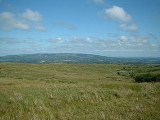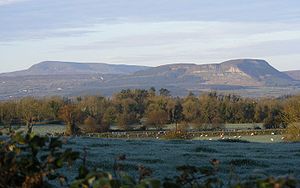
Cuilcagh
Encyclopedia

Mountain
Image:Himalaya_annotated.jpg|thumb|right|The Himalayan mountain range with Mount Everestrect 58 14 160 49 Chomo Lonzorect 200 28 335 52 Makalurect 378 24 566 45 Mount Everestrect 188 581 920 656 Tibetan Plateaurect 250 406 340 427 Rong River...
in the Breifne
Kingdom of Breifne
The Kingdom of Breifne or Bréifne was the traditional territory for an early Irish tribal group known as the Uí Briúin Bréifne...
area and the 165th highest on the island of Ireland
Ireland
Ireland is an island to the northwest of continental Europe. It is the third-largest island in Europe and the twentieth-largest island on Earth...
. The summit lies on the border between County Fermanagh
County Fermanagh
Fermanagh District Council is the only one of the 26 district councils in Northern Ireland that contains all of the county it is named after. The district council also contains a small section of County Tyrone in the Dromore and Kilskeery road areas....
(in Northern Ireland
Northern Ireland
Northern Ireland is one of the four countries of the United Kingdom. Situated in the north-east of the island of Ireland, it shares a border with the Republic of Ireland to the south and west...
) and County Cavan
County Cavan
County Cavan is a county in Ireland. It is part of the Border Region and is also located in the province of Ulster. It is named after the town of Cavan. Cavan County Council is the local authority for the county...
(in the Republic of Ireland
Republic of Ireland
Ireland , described as the Republic of Ireland , is a sovereign state in Europe occupying approximately five-sixths of the island of the same name. Its capital is Dublin. Ireland, which had a population of 4.58 million in 2011, is a constitutional republic governed as a parliamentary democracy,...
), and is the highest point in both counties. Water from the southern slope flows underground until it emerges some miles away in the Shannon Pot
Shannon Pot
Shannon Pot is a small lake in the Karst topography found on the slopes of Cuilcagh Mountain in County Cavan, Ireland. An aquifer-fed naturally fluctuating pool, it is the traditional source of the River Shannon.The pool itself is approximately in diameter. It was first explored by divers in 1971...
, the traditional source of the River Shannon
River Shannon
The River Shannon is the longest river in Ireland at . It divides the west of Ireland from the east and south . County Clare, being west of the Shannon but part of the province of Munster, is the major exception...
.
Flora and fauna
Cuilcagh Mountain has one of the largest expanses of blanket bog in Northern Ireland, on a relatively high elevation upland landscape, bounded by limestone grassland to the north and montane habitats to the south. The blanket bogBlanket bog
Blanket bog or blanket mire is an area of peatland, forming where there is a climate of high rainfall and a low level of evapotranspiration, allowing peat to develop not only in wet hollows but over large expanses of undulating ground. The blanketing of the ground with a variable depth of peat...
exhibits a wide range of characteristic vegetation and structural features, with well-developed pool, hummock and lawn features, acid flushes and bog
bursts. The bog vegetation is characterised by luxuriant Sphagnum
Sphagnum
Sphagnum is a genus of between 151 and 350 species of mosses commonly called peat moss, due to its prevalence in peat bogs and mires. A distinction is made between sphagnum moss, the live moss growing on top of a peat bog on one hand, and sphagnum peat moss or sphagnum peat on the other, the...
mosses but over most of the site dwarf-shrubs and graminoid herbaceous species dominate. The Cuilcagh area supports a rich assemblage of upland insects, and is one of the most important sites in Ireland for these species. Species recorded include the water beetles Agabus melanarius, Agabus arcticus, Dytiscus lapponicus, Stictotarsus multilineatus, Hydroporus longicornis and Hydroporus morio and the water bugs Glaenocorisa propinqua and Callicorixa wollastoni. Lough Atona is the main locality for these species.
Geopark
In 2007 the Cuilcagh Mountain Park was joined with popular tourist attraction the Marble Arch CavesMarble Arch Caves
The Marble Arch Caves are a series of natural limestone caves located near the village of Florencecourt in County Fermanagh, Northern Ireland. They are formed by water draining off the northern slopes of Cuilcagh mountain.- History of exploration :...
and the Cladagh Glen Nature Reserve to make the Marble Arch Caves and Cuilcagh Mountain European Geopark. In September 2008 the park was given UNESCO
UNESCO
The United Nations Educational, Scientific and Cultural Organization is a specialized agency of the United Nations...
Global Geopark status under the name of the Marble Arch Caves Global Geopark. The Geopark is protected and managed by Fermanagh District Council
Fermanagh District Council
Fermanagh District Council is a local council in Northern Ireland. The borders of the district are very similar to those of the traditional County Fermanagh, containing all of that county plus a small section of County Tyrone in the Dromore Road and Kilskeery Road areas. Council headquarters are...
through the staff of the Marble Arch Caves Visitor Centre.
Ramsar site
The Cuilcagh Mountain Ramsar site (wetlands of international importance designated under the Ramsar ConventionRamsar Convention
The Ramsar Convention is an international treaty for the conservation and sustainable utilization of wetlands, i.e., to stem the progressive encroachment on and loss of wetlands now and in the future, recognizing the fundamental ecological functions of wetlands and their economic, cultural,...
), is 2744.45 hectares in area, at Latitude 54 13 26 N and Longitude 07 48 17 W. It was designated a Ramsar site on 31 December 1998. The site qualified under Criterion 1 of the Ramsar Convention
Ramsar Convention
The Ramsar Convention is an international treaty for the conservation and sustainable utilization of wetlands, i.e., to stem the progressive encroachment on and loss of wetlands now and in the future, recognizing the fundamental ecological functions of wetlands and their economic, cultural,...
because is a large and relatively intact example of a blanket bog and one of the best examples of this habitat in the United Kingdom
United Kingdom
The United Kingdom of Great Britain and Northern IrelandIn the United Kingdom and Dependencies, other languages have been officially recognised as legitimate autochthonous languages under the European Charter for Regional or Minority Languages...
. It also contains a comparatively high-altitude example of an oligotroph
Oligotroph
An oligotroph is an organism that can live in an environment that offers very low levels of nutrients. They may be contrasted with copiotrophs, which prefer nutritionally rich environments...
ic lake, Lough Atona. The site also qualified under Criterion 2 because it supports numbers of rare, vulnerable or endangered species. It is one of the most important upland breeding sites in Northern Ireland for Eurasian Golden Plover
Eurasian Golden Plover
The European Golden Plover is a largish plover. This species is similar to two other golden plovers. American Golden Plover, Pluvialis dominiica, and Pacific Golden Plover, Pluvialis fulva, are both smaller, slimmer and relatively longer-legged than European Golden Plover, and both have grey...
, an Irish Red Data Book Species. Other Irish Red Data book bird species occurring on the site include Merlin
Merlin (bird)
The Merlin is a small species of falcon from the Northern Hemisphere. A bird of prey once known colloquially as a pigeon hawk in North America, the Merlin breeds in the northern Holarctic; some migrate to subtropical and northern tropical regions in winter.-European and North American...
. The bog is also occasionally used for feeding by Greater White-fronted Geese.
History
In the 1609 Plantation of Ulster, Cuilcagh formed part of lands which were granted to John Sandford Esq. by letters patent dated 7th July 1613 (Pat. 11 James I – LXXI – 38, ‘Quilkagh’). It was later granted to Sir Toby Caulfield, Master of the Ordnance by letters patent of 12th July 1620 (Pat. 19 James I. XI. 45, ‘Quilkagh’).External links
- BBC Learning Northern Ireland: Landscapes Unlocked - Aerial footage from the Sky High series explaining the physical, social and economic geography of Northern Ireland.

